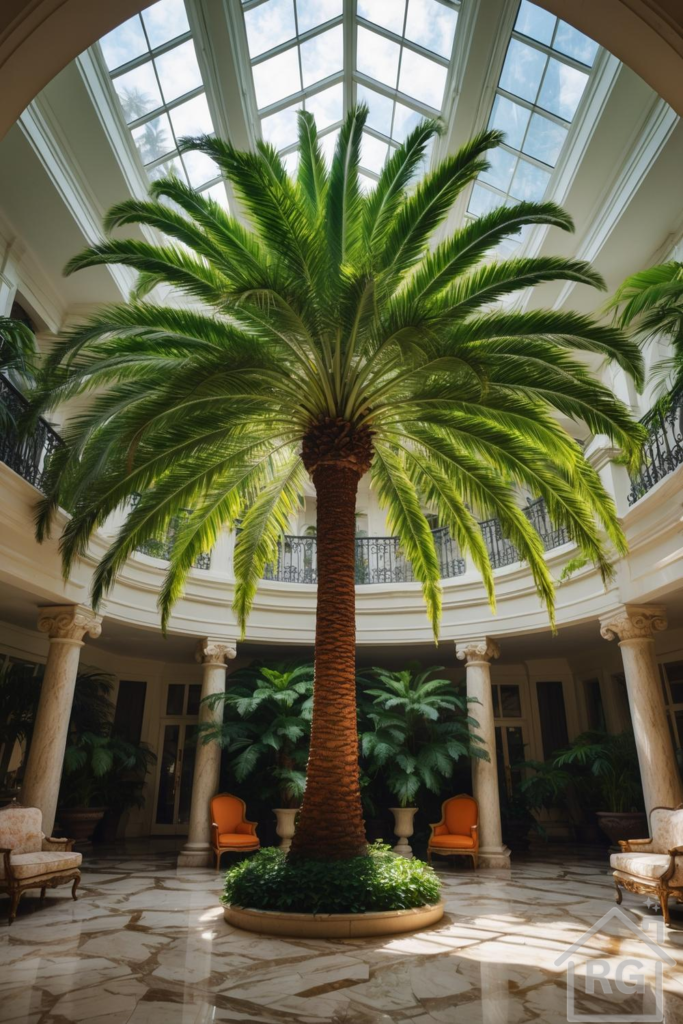
The Allure of the Atrium: Bringing Nature and Light Indoors
There’s an undeniable magic to a well-designed atrium. It’s a unique space where the boundaries between indoors and outdoors blur, allowing natural light to flood in and greenery to thrive. This creates a sanctuary of peace, elegance, and a profound connection with nature.
Imagine a grand conservatory, a towering palm tree reaching for a glass-panelled sky – it’s a picture of timeless luxury. This guide will explore the key elements and design principles to help you understand and potentially recreate such a breathtaking space, or simply incorporate its inspiring spirit into your own home.
Section 1: The Verdant Heart – The Statement Plant
At the core of many stunning atriums is a magnificent statement plant, often a tall tree like the palm featured. This living sculpture serves as the focal point, drawing the eye upwards and infusing the space with life and vibrant green hues.
Choosing Your Champion
When selecting a large-scale plant for an atrium, consider these crucial factors:
- Scale: The plant should be proportional to the height and volume of the space. A towering palm or a mature Ficus tree can make a dramatic impact in a high-ceilinged room.
- Light Requirements: Most large indoor trees need ample bright, indirect light. An atrium with a skylight is ideal. Always research specific plant needs before committing.
- Maintenance: Larger plants require more significant care, including watering, occasional pruning, and pest management. Be realistic about the commitment involved.
- Aesthetics: Consider the plant’s form, leaf texture, and overall visual appeal. The feathery fronds of a palm create a tropical, airy feel, while the broad leaves of a Fiddle Leaf Fig offer a more contemporary look.
Alternatives for Smaller Spaces
If a giant tree isn’t feasible for your space, don’t despair! You can still create a lush focal point with a carefully arranged cluster of smaller, varied plants, a tall and slender species like a Dracaena, or even a beautifully designed vertical garden.
Section 2: Let There Be Light – The Power of the Skylight
Natural light is the lifeblood of any successful atrium. A large skylight, like the expansive glass ceiling in the inspiration image, is truly transformative. It not only nourishes the plants but also illuminates the architectural features and materials, creating a bright, airy, and uplifting atmosphere.
Designing with Light
The interplay of light and shadow adds depth and dynamism to the space. Consider the following:
- Orientation: The direction your skylight faces will significantly affect the quality and intensity of light throughout the day.
- Diffusion: Using frosted or specially coated glass can help diffuse harsh sunlight, preventing scorching of delicate plants and creating a softer, more even glow.
- Architectural Integration: The skylight’s design should seamlessly complement the overall architectural style of your space. Panelled glass, as seen in many classic designs, adds a structured, elegant feel.
The gentle light blue hue filtering through the glass on a clear day can add another layer of color and serenity to the space, beautifully mimicking the open sky.
Section 3: Grounded in Luxury – Flooring and Foundations
The flooring in an atrium plays a crucial role in defining its character and overall aesthetic. In the featured space, polished marble in creamy beige and warm brown tones exudes opulence and reflects light beautifully, enhancing the sense of spaciousness and grandeur.
Material Choices
- Marble: A classic choice, known for its durability and timeless elegance. Its natural veining adds unique character, with colors ranging from pristine whites to rich, darker shades.
- Stone: Materials like travertine or limestone offer a similar luxurious feel with different textural qualities and color palettes.
- Polished Concrete: A more contemporary option that can be stained or finished to achieve various looks, from industrial chic to sleek modern.
The way the palm tree is planted, with a neat circular bed at its base, integrates it seamlessly into the flooring design. This detail is important for both aesthetics and practicality, allowing for proper drainage and care of the statement plant.
Section 4: Architectural Elegance – Columns, Curves, and Verticality
The architectural elements within an atrium contribute significantly to its perceived grandeur. Stately columns, often painted in soft, neutral tones like a gentle cream, can provide structural support while adding a classical rhythm and drawing the eye upwards, emphasizing the room’s impressive height.
Embracing Vertical Space
The circular design of the central space, often echoed by curved balconies on upper levels, creates a harmonious and dynamic flow. Wrought iron railings on balconies can introduce a contrasting texture and a touch of intricate detail, often in a dark, grounding color that provides visual weight.
These features work together to create a sense of enclosure and intimacy within the larger volume, while still maintaining an open and airy feel. High ceilings are essential for accommodating tall plants like palms and allowing light to penetrate deeply into the space.
Section 5: A Symphony of Colors and Textures
The success of a captivating atrium design often lies in its sophisticated blend of colors and textures, creating a rich and immersive sensory experience.
The Palette
The color scheme should be both calming and invigorating, drawing inspiration from nature:
- Earthy Greens: From the deep emerald of large palm fronds to the lighter, varied greens of other foliage, these shades are essential for bringing nature indoors.
- Warm Creams and Beiges: Dominating walls, columns, and often the flooring, these neutrals create a bright, expansive backdrop and enhance light reflection.
- Rich Browns: The textured bark of tree trunks and the natural veins in stone or marble add warmth and grounding elements.
- Vibrant Accents: Pops of color, like vibrant orange or terracotta in accent chairs or decorative pots, can inject energy and a contemporary touch.
- Cool Blues: The subtle blue of the sky visible through the skylight, or even hints of blue in decor, can add a serene, airy quality.
- Dark Accents: Elements like black wrought iron or dark wood provide strong contrast, definition, and a sense of sophistication.
Textural Harmony
Imagine the feel of the space: the cool smoothness of polished marble underfoot, the slightly rough texture of a palm’s trunk, the delicate flutter of its fronds, and the sleekness of glass.
Consider also the soft give of upholstered fabric on armchairs and the cool, solid feel of wrought iron or stone. This rich textural diversity is key to creating a space that is not only visually interesting but also truly inviting to experience.
Section 6: Furnishing the Grandeur – Seating and Decor
Furniture choices in such a grand space should be carefully considered to complement the scale and style without overwhelming the natural and architectural beauty. The goal is to enhance, not compete.
Strategic Seating
The placement of armchairs and other seating should invite relaxation and contemplation. Vibrant accent chairs, perhaps in a bold orange or deep teal, can act as focal points within seating areas, their modern silhouettes contrasting beautifully with classical architecture. Elsewhere, more traditional armchairs with patterned upholstery in muted tones can offer a nod to timeless elegance.
Less is More
In a space dominated by a magnificent tree and striking architecture, decor should generally be minimal. The plants themselves are the primary decorative elements. The focus should remain on the interplay of light, space, and natural forms, allowing the inherent beauty of the atrium to shine.
Section 7: Bringing Your Atrium Dream to Life – Practical Tips
Inspired to create your own light-filled, green oasis? Here are some practical tips to get you started:
- Assess Your Space: Identify areas that receive good natural light. Could a skylight be realistically added? Do you have vertical space to play with for taller plants or hanging elements?
- Start with a Focal Plant: Choose a plant (or a cohesive group of plants) that will be the star of your indoor garden. Research its needs thoroughly.
- Layer Materials: Combine different textures like stone, wood, glass, and fabrics to add depth, interest, and warmth to your design.
- Embrace Natural Light: Maximize it with large windows, mirrors to reflect light, and light-colored walls and ceilings.
- Consider Scale: Ensure furniture and plants are appropriately sized for your space. In a smaller room, a collection of well-chosen smaller plants can be just as impactful as one large tree.
- Color Wisely: Use a base of neutrals to create a calm backdrop, then add pops of color with plants, textiles, or carefully chosen accent furniture.
- Plan for Maintenance: Indoor gardens require ongoing care. Choose plants suited to your lifestyle, experience, and the amount of time you can commit to their upkeep.
Conclusion: An Oasis of Your Own
An atrium, like the stunning example depicted, is more than just a room; it’s an experience. It’s a testament to the power of thoughtful design to connect us with the natural world, even within the confines of our homes.
While not everyone has the space or resources for such a grand conservatory, the core principles—maximizing light, incorporating greenery, using luxurious natural materials, and creating a strong focal point—can be applied to spaces of any size. By thoughtfully combining these elements, you can cultivate your own indoor sanctuary: a place of beauty, tranquility, and daily inspiration.
